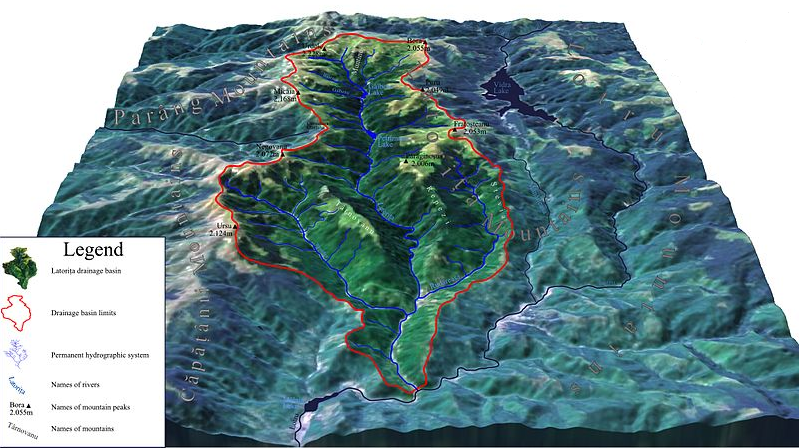A catchment area is a portion of land from which all precipitation is collected and carried to a single point.
In order to facilitate the management and conservation of hydrological resources, hydrologists have divided the territory into several sections known as catchment areas. These represent areas surrounding different river systems.
The boundary of a catchment area is defined by natural boundaries. Under the action of gravity, water flows from the highest point to the lowest (from upstream to downstream). The boundary between two catchment areas is therefore located on a line that follows the crest of the surrounding mountains and hills. These boundaries are known as the watershed (or ridgeline). When there is precipitation, it will fall on one side or the other of this divide: it will then flow into different catchment areas. Catchment areas include both surface and groundwater flows.

A number of factors can influence the way water flows within a catchment area.
- Topography: The steeper the slope, the faster the water flows.
- Geology: Water flows more quickly over porous or rocky ground than over clay, which retains a lot of water.
- Climate: Water flows more quickly in an environment subject to periods of rainfall than in periods of drought.
- Vegetation: Water that runs off the ground is slowed down by the presence of a lot of vegetation.
- Agricultural, industrial and urban development: Dams and other structures prevent the free flow of water.
Catchment areas can be seen as a network of interlocking watercourses. There are different levels of catchment depending on the scale being studied:
- Sub-catchment (local catchment areas): A network of smaller streams and river tributaries.
- Catchment (secondary catchment) : Network of tributaries (rivers and lakes) located further upstream.
- Fluvial catchment: Network of watercourses that flow into rivers.
- Oceanic catchment: Network of rivers flowing towards the ocean.
All other levels are sub-basins of the oceanic catchment.
In North America, there are 5 main ocean drainage basins. They are represented in the image below. They are the Pacific Ocean watershed (in yellow), the Gulf of Mexico watershed (in orange), the Atlantic Ocean watershed (in blue), the Hudson Bay watershed and the Arctic Ocean watershed (grouped together in the red section).

As for the basin represented by the colour pink, this is a catchment area known as the ‘Great Basin’, which groups together a number of watercourses in a desert region of the United States.
Certain human activities can have a significant impact on catchment areas. For example, clear-cutting (or excessive deforestation) can cause surface water to flow more quickly. This accelerated flow can increase soil erosion, leading to flooding and landslides.
In addition, pollution of the hydrosphere, through the release of toxic products into the water or through the leaching of residues produced by industries and mines, can contaminate the water source near the industry in question. However, according to the watershed principle, this water will flow into other catchment areas, contaminating several bodies of water. The impact on people living near these watercourses can therefore be very harmful.
In the image above, water contamination has occurred at point X. It is therefore possible to determine which locations will be affected by this contamination by looking at the water flow map.
- Point A will not be contaminated because it is located upstream of point X. Since water flows from upstream to downstream, it is impossible for water to flow upstream to contaminate this point.
- Point B will not be contaminated, because the contaminated river is not a tributary of this point. In other words, the contaminated water at point X does not flow into the river where point B is located.
- Points C and D will be contaminated, as these two points are located downstream of point X. The water from this point will therefore flow into each of the points, contaminating the water and soil.
